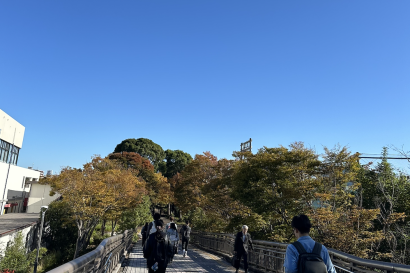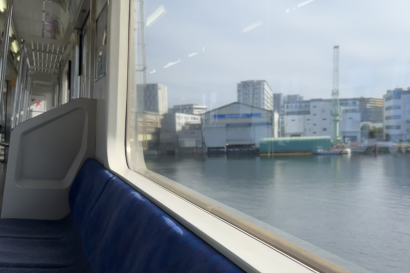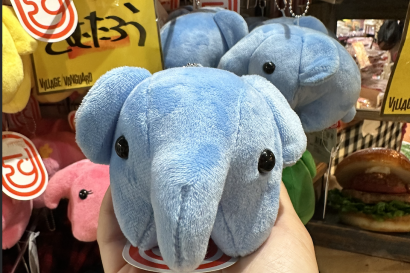The final IES-sponsored field trip took us to Kamakura, a hub of spiritual culture in Japan. Home to countless Buddhist temples and numerous Shinto shrines, the town draws tourists both from all over Japan and all over the world. This time of year, it is most famous for its hydrangeas, which bloom en masse around mid-June.
We left Makuhari under cloudy skies, all worried about the rain forecasted for the afternoon and wondering if this would be a repeat of our rainy visit to Okinawa. However, by the time we reached Kamakura–a two-hour bus ride away–the skies looked much less threatening. I even had to break out my sunscreen and hat.
Out first stop was Engakuji Temple, which is known as the second of Kamakura’s five great Zen temples. As expected for the season, it was packed with tourists. Engakuji’s architecture and extensive temple complex are as impressive as its history of destruction in earthquakes and fires. However, walking through the temple grounds, you’d never guess that nearly all of the buildings have been rebuilt several times. The buildings and statues were also dotted with a symbol of three triangles stacked to form one big triangle. Though this symbol is familiar to gamers as the Triforce, it is actually the clan crest of the Hojo clan, which helped establish the temple.
Engakuji’s real selling point, however, were its walkways lined with blooming hydrangeas. There were hydrangea bushes of every color and hue, and they were swarmed by professional and iPhone photographers alike. It seemed as though half as much attention was being paid to the temple buildings as the flowers. I managed to get more than a few pictures myself.
Our next stop after Engakuji was Tsurugaoka Hachiman-gu, Kamakura’s most important shrine. This shrine is dedicated to Hachiman, the god of samurai, but many other Shinto deities are also enshrined there. These include Inari-kami and the defied spirits of past emperors.
The sun finally came out, and Hachiman-gu was awash with tourists, school groups, and foreigners. Food carts lining the road up to the shrine sold assorted candy or chocolate-covered fruit on sticks. There was even a traditional Japanese wedding going on, with the bride in a snow-white kimono and round hood. We were given two hours to wander the shrine complex; I bought an omamori charm to decorate my bag, and my friend bought an ema to join the wall of ema written in various languages.
After we visited the shrine to Inari and wandered around a street lined with tourist shops and expensive food, we meandered back to the shrine complex and crossed a bridge we hadn’t gone over before. This bridge crossed a lily-covered pond and led us into a smaller shrine. This place turned out to be the highlight of the trip, for perched in the trees and pecking at the ground were assorted doves and pigeons. For 50 yen you could buy a bag of pigeon feed, and the birds would come right up to you and eat out of your hand. They would even fly to perch on your arm if you held the food above their heads. Needless to say, my friend and I have about a million pictures of us feeding birds like Disney princesses, and I can now add “had a bird on my head once” to my list of achievements. The one drawback is that our arms ended up looking like we’d run through a field of brambles.
We were sure to wash our hands afterwards.
After departing Tsurugaoka Hachiman-gu we departed for the most iconic attraction in Kamakura–Daibutsu, the second largest Buddha statue in Japan. When it was first built, the Buddha was housed inside a temple hall. After the building was washed away by a tsunami in the 15th century, the Buddha has stood in open air ever since.
It was, true to its name, very big–13.35 meters, or about 44 feet tall. The big bronze Buddha loomed over the visitors, calmly watching over them in seated meditation. Although it is part of a temple complex, it seemed much more like a public park than a place of worship. Nonetheless, a sign in front of the gates kindly asked visitors to show respect.
We were given much less free time here, so we had to scramble to buy souvenirs and take pictures. With so many tourists milling around, it was hard to isolate the statue itself in photos.
From the Daibutsu we walked to our next destination, rather than bussing there as we had before. Our final stop was Hasedera temple, which is famous for its statue of Kannon, the goddess of mercy. Hasedera was also built into a hill, and much climbing was required to reach the main temple building. On the way we passed quaint gardens, and walls lined with tiny statues dedicated to the spirits of the dead.
Hasedera was also crowded. One of its main attractions–a hill covered in blooming hydrangea–had a line that was two hours long. The temple boasted a good view of Kamakura and the bay, but one had to wade one’s way through a considerable crowd to get to the viewing area. Despite the crowds, I was able to get in to see the famous statue of Kannon. It was incredibly tall and shone impressively in gold. I bought another omamori here, and took pictures of the small Jizo statues. Finally, a friend and I ventured into a small cave called Bentenkutsu, which housed statues of Benten and other minor gods that had been carved into the cave walls. Deeper into the cave the ceiling lowered suddenly, and guests practically had to crawl through dim tunnels to visit the other parts of the cave. Tiny statues of a feminine deity lined shelf-like structures on the floor of several caverns; you could add another to the rows by purchasing one from a table. Claustrophobia-inducing as it was, Bentenkutsu was probably my favorite part of Hasedera.
After exiting Bentenkutsu, it was just about time to leave. Though Kamakura was beautiful and interesting, doing four things in one day was exhausting, and I was glad to be getting back on a bus for two hours’ rest. We returned to a rainy Makuhari and marveled at our luck–Kamakura had been sunny almost all day.
As with most everything I’ve blogged about thus far, I would highly recommend a trip to Kamakura if you’re ever in the area. If temples and shrines aren’t really your thing, you might be a little bored, but I’d say a visit to the Daibutsu is at least worth the trip.



















Lauren Fellows
<p><span style="color: rgb(29, 29, 29); font-family: Arial, Verdana, sans-serif; font-size: 12px; line-height: normal; background-color: rgb(237, 237, 237);">Lauren Fellows is a Japanese major, geology minor studying at the University of Puget Sound in Tacoma, WA. She hails from Boulder, Colorado, and is glad to be going to school in a place with both mountains and a water feature (the weather, however, leaves something to be desired). Lauren is a huge dork who loves drawing, watching anime, writing stories, and taking pictures of toys when she isn’t spending long hours training to beat the Elite Four in the latest Pokémon game. She’s ventured to a few places outside the United States, most notably France and Israel, but this is her first time in Japan and she is SUPER EXCITED. While in Japan she plans to make friends from near and far, experience anime culture in its natural habitat, and explore an urban jungle unlike anywhere she's ever been before. The adventure of a lifetime is just over the horizon!</span></p>






